While the charcoal burning
pit forge is sufficient to do almost any kind of work and is the cheapest and simplest forge to construct it has faults.
The primary fault is the simple fact that the forge IS in the ground.
Water can run into the pit putting out the fire, making mud of the clay, making the fire difficult to maintain or cooling the fire as it produces steam.
To overcome this the pit forge can be put under a shelter and the surrounding ground graded for drainage.
The forge being in the ground also means that the smith and his helpers must work sitting, squatting or kneeling.
This has disadvantages as well but has remained a traditional working method in many countries.
However, in the West we find it clumsy and uncomfortable.
We prefer to work standing or sitting on a chair or stool.
At the pit forge the smith and his helper have limited reach making it difficult to access tools and limiting work size.
It also reduces the possibility of multiple work stations such as
anvil,
vise,
swage block.
The Japanese overcame some of these limitations by digging pits with different levels or shelves for the smith to work from.
While advances in forge construction overcome these faults the basics of the forge remain the same.
It is still a container to hold the fuel and guide the blast to bottom of the fire.
A modern solid fuel forge is little more than a pit forge raised out of the ground to a convienient working height.
In primitive situations these were no more than a wooden box containing the pit forge, its soil fill and clay lining insulating the wood from the fire.
One of the earliest advances in forge construction was the shield stone.
The shield stone protects the bellows and its user from the intense heat of the fire and simplifies forge construction.
The shield stone replaces a mound of dirt and random stones found on site with a shaped or "manufactured" stone that becomes a reusable forge part that can be carried to a new site.
The most advanced shield stone was the type with a hole bored through it making a fire resistant nozzle.
Shield stones must be made of a heat resistance stone.
Many are made of soap stone as it is heat resistant and easy to drill.
These are also often decorated due to the ease of carving.
The shield stone is one of many indicators of socioeconomic change.
It is a possession of value that is carried from one place to another and is a step toward raised forges and permanent masonry forges.
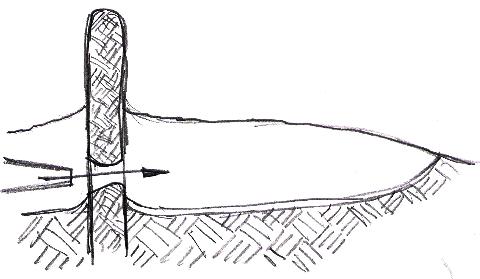
Side Blown Shield Stone Forge
Forges in Northern Europe used a "shield Stone" to protect the bellows from heat and to create the focused air blast.
These are often called a "Viking" forge.
The stone is often soap stone which is easy to carve and heat resistant as well.
These evolved from the pit forge where it was also common to have a shield stone above the air tunnel to protect the bellows and the operator.
They were blown with paired bellows.
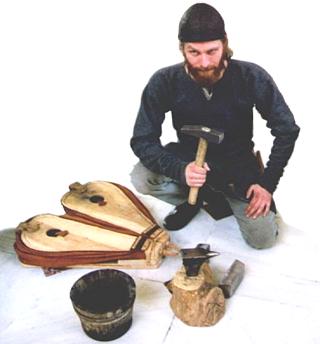
Small portable Viking Forge setup.
|
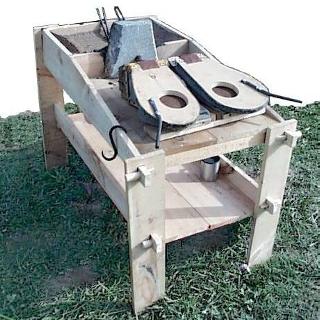
Portable Viking Forge setup
|
These Viking reenactor forges are based on historical and archeological evidence.
These are all portable forges ranging from small ship's repair setup to colonizing forges.
The Viking forge used a soap stone shield stone and a metal pan to protect surrounding wood.
It is also a surface or above ground forge, not a pit.
This is a step toward building raised forges.
However, many primitive forges are simply a wood box on legs filled with soil
insulation and are usually clay lined like our drawing in part one.
It is merely the pit on legs.
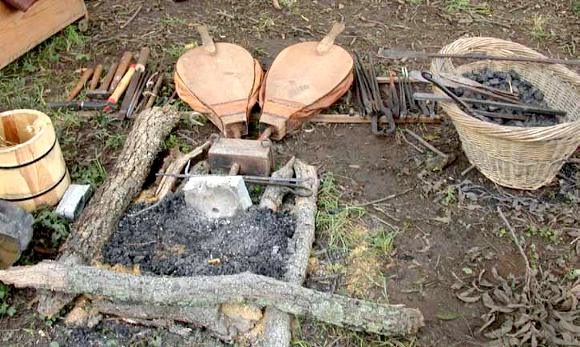
Longship Company Forge at the Hastings reenactment. Photo Bruce Blackistone
A world away, in fact on the other side of the planet, in Japan and the South Pacific, the side blown trough forge was developed.
This masonry forge is side blown through a wall similar to a shield stone with another wall parallel to it.
This forms a trough to hold the fuel in a restricted space.
Being open ended has made it the preferred bladesmith's forge in the region.
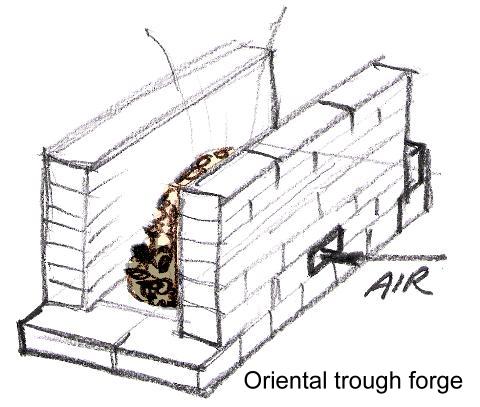
The Oriental "trough" forge.
A
box bellows was traditionally used with the trough forge but it would work with any source of blown air.
This style forge is used throughout the Western Pacific basin and Far East.
They are built from fired or unfired bricks, adobe, rubble and clay or other methods.
They can be built with loose bricks and rearranged as necessary.
Depending on size they may have more than one air entrance.
When using brick it is useful to make the width of the trough just a little wider than the length of a brick so that bricks can be used to deepen the fire or block one end.
The Japanese build their trough forge on the ground and sit next to it.
But other Pacific basin smiths build them raised off the ground on a masonry base to work while standing.
In modern forge shops they are built of refractory brick and often put on a table or steel stand.
If put on a wood bench of table there must be insulation between the brick and the wood as neither common brick or refractory brick is an insulator.
Refractory ceramic fiber such as
Kaowool is often used for this purpose.
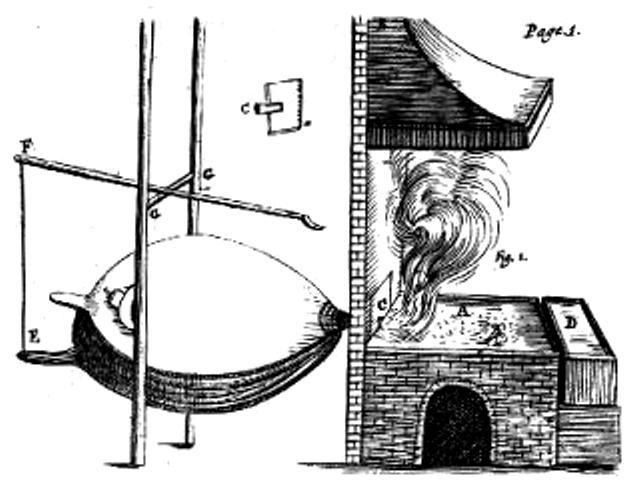
18th Century Brick Forge Diagram from Moxon
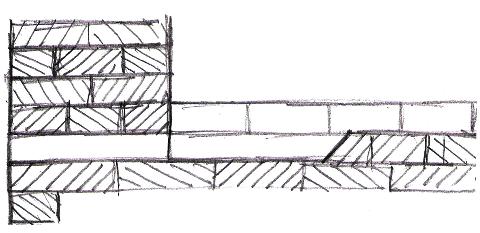
Side Blown Brick Forge
In a brick forge the blast just passes through a rectangular tunnel in the brick.
These were blown with paired bellows, double chambered bellows and later hand crank and electric blowers.
The exhaust into the chimney is often a "side draft" some distance above the fire.
The European style "hood" shown in the Moxon drawing would have a huge stack with an open area at least 1/2 as big as the bottom opening or larger.
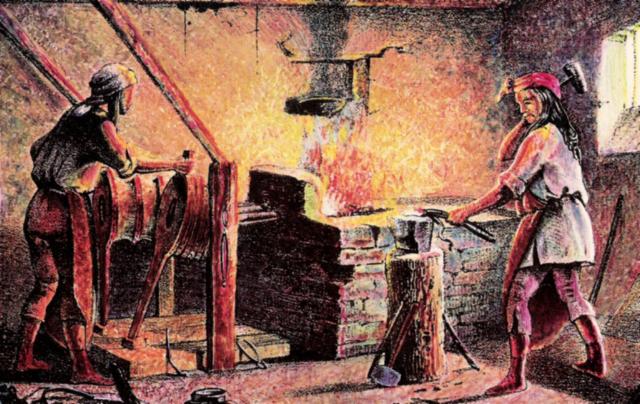
Spanish abobe forge with sideblast paired accordian bellows.
The abobe forge above is blown by two single action accordian bellows and uses a shield wall similar to the Viking shield stone above.
These are just one developmental step (raised and with shield wall) from pit forges.
Many modern brick forges are hybrid forges built using the cast firepot and tuyere out of a modern portable forge.
Building these starts with the production parts that you should hope will be available to replace in the future.
Plan to be able to use a different replacement.
The arch is often used for the cleanout location.
Blowers on hybrid forges range from bellows, to hand crank blowers to electric powered blowers depending on the smith's preference.
Those with electric controls may have them embedded in the masonry and either obvious or disguised.
The stack on the forge should use a side draft design
but details will also need to meet local building codes if they apply.
Article In Progress



The primary fault is the simple fact that the forge IS in the ground. Water can run into the pit putting out the fire, making mud of the clay, making the fire difficult to maintain or cooling the fire as it produces steam. To overcome this the pit forge can be put under a shelter and the surrounding ground graded for drainage.
The forge being in the ground also means that the smith and his helpers must work sitting, squatting or kneeling. This has disadvantages as well but has remained a traditional working method in many countries. However, in the West we find it clumsy and uncomfortable. We prefer to work standing or sitting on a chair or stool. At the pit forge the smith and his helper have limited reach making it difficult to access tools and limiting work size. It also reduces the possibility of multiple work stations such as anvil, vise, swage block. The Japanese overcame some of these limitations by digging pits with different levels or shelves for the smith to work from.
While advances in forge construction overcome these faults the basics of the forge remain the same. It is still a container to hold the fuel and guide the blast to bottom of the fire.
A modern solid fuel forge is little more than a pit forge raised out of the ground to a convienient working height. In primitive situations these were no more than a wooden box containing the pit forge, its soil fill and clay lining insulating the wood from the fire.
One of the earliest advances in forge construction was the shield stone. The shield stone protects the bellows and its user from the intense heat of the fire and simplifies forge construction. The shield stone replaces a mound of dirt and random stones found on site with a shaped or "manufactured" stone that becomes a reusable forge part that can be carried to a new site. The most advanced shield stone was the type with a hole bored through it making a fire resistant nozzle. Shield stones must be made of a heat resistance stone. Many are made of soap stone as it is heat resistant and easy to drill. These are also often decorated due to the ease of carving.
The shield stone is one of many indicators of socioeconomic change. It is a possession of value that is carried from one place to another and is a step toward raised forges and permanent masonry forges.
Side Blown Shield Stone Forge
Forges in Northern Europe used a "shield Stone" to protect the bellows from heat and to create the focused air blast. These are often called a "Viking" forge. The stone is often soap stone which is easy to carve and heat resistant as well. These evolved from the pit forge where it was also common to have a shield stone above the air tunnel to protect the bellows and the operator. They were blown with paired bellows.
Longship Company Forge at the Hastings reenactment. Photo Bruce Blackistone
A world away, in fact on the other side of the planet, in Japan and the South Pacific, the side blown trough forge was developed. This masonry forge is side blown through a wall similar to a shield stone with another wall parallel to it. This forms a trough to hold the fuel in a restricted space. Being open ended has made it the preferred bladesmith's forge in the region.
The Oriental "trough" forge.
A box bellows was traditionally used with the trough forge but it would work with any source of blown air. This style forge is used throughout the Western Pacific basin and Far East. They are built from fired or unfired bricks, adobe, rubble and clay or other methods. They can be built with loose bricks and rearranged as necessary. Depending on size they may have more than one air entrance. When using brick it is useful to make the width of the trough just a little wider than the length of a brick so that bricks can be used to deepen the fire or block one end.
The Japanese build their trough forge on the ground and sit next to it. But other Pacific basin smiths build them raised off the ground on a masonry base to work while standing. In modern forge shops they are built of refractory brick and often put on a table or steel stand. If put on a wood bench of table there must be insulation between the brick and the wood as neither common brick or refractory brick is an insulator. Refractory ceramic fiber such as Kaowool is often used for this purpose.
18th Century Brick Forge Diagram from Moxon
Side Blown Brick Forge
In a brick forge the blast just passes through a rectangular tunnel in the brick. These were blown with paired bellows, double chambered bellows and later hand crank and electric blowers. The exhaust into the chimney is often a "side draft" some distance above the fire. The European style "hood" shown in the Moxon drawing would have a huge stack with an open area at least 1/2 as big as the bottom opening or larger.
Spanish abobe forge with sideblast paired accordian bellows.
The abobe forge above is blown by two single action accordian bellows and uses a shield wall similar to the Viking shield stone above. These are just one developmental step (raised and with shield wall) from pit forges.
Many modern brick forges are hybrid forges built using the cast firepot and tuyere out of a modern portable forge. Building these starts with the production parts that you should hope will be available to replace in the future. Plan to be able to use a different replacement. The arch is often used for the cleanout location.
Blowers on hybrid forges range from bellows, to hand crank blowers to electric powered blowers depending on the smith's preference. Those with electric controls may have them embedded in the masonry and either obvious or disguised. The stack on the forge should use a side draft design but details will also need to meet local building codes if they apply.
Article In Progress